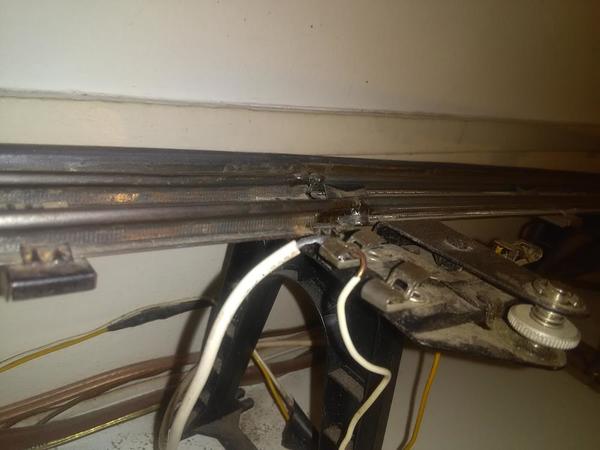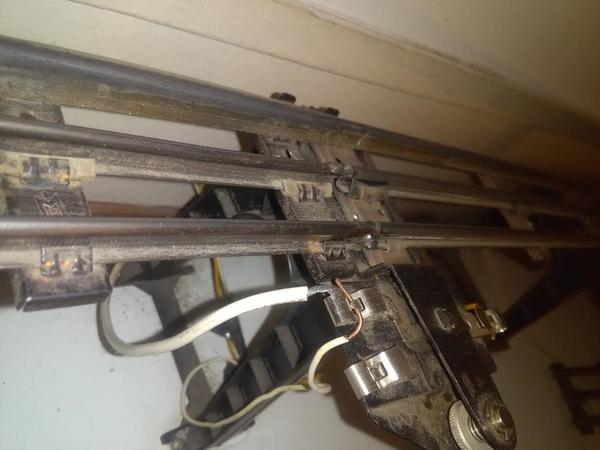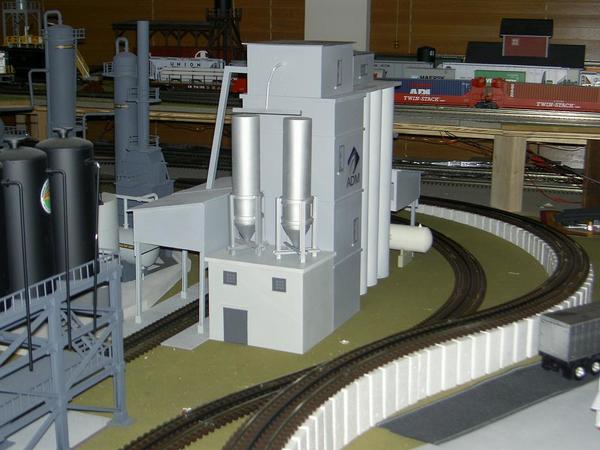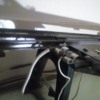I'm designing a new smaller layout for the available space. It's going to have two levels and I'd like to tie them together, but I only have about 18' for connecting the two levels. Thinking I'll need a 7"- 7.5" separation between rail tops to account for plywood and head clearance of base level. Reading Armstrong's book, he says even a very steep grade is doable - if kept short because the bulk of the train's weight won't be on the grade. Anyway, I'm looking for people here with real life experience on what can really be done and work. Steepness and length so that my locomotives aren't stuck, spinning their wheels, and my couplers don't scream for mercy. I run all kinds of equipment mostly from Lionel and MTH from longish passenger trains to freight. Locomotives are everything from RK Scale RS-1s to Vision Big Boys. Thanks!
Replies sorted oldest to newest
They weren't running Big Boys in Armstrongs day. The length of that is going to be another limiting factor. You transition into grades will need to be soft enough to keep all those wheels planted.
You might teeter totter on the high end of the grade at least.
The bottom of the grade, hard transition, cow catchers will short on the center rail.
In my 2...15' up to 7.5" I have about 5% ("dwn"4.5% & "up"5.5%) I just dont think that Big Boy will like the top. The transitions barely let me run my PW steam.
To increase traction eack grade has one outside rail covered with two sided tape for winter window insulating plastic, de-tacked slightly by a short nap cloth. The tape lasts me about a year before I lay down a new strip. Sometimes over the old, sometimes fresh.
Really good point. Our former layout had approx 3% grades and the way to overcome the "teetering" was to ensure very gentle transitions at the start and exit of the grades. Of course, with more track devoted to the transitions, less track was used in the actual straight "core" portion of the grade, making the grade steeper.
So, you're saying at 5% grade you need sticky tape to ensure the train makes it up the hill?
Actually, John Armstrong ran what he called a "Super Allegheny" on his Canandaigua Southern layout.
On my old layout I had the same issue as you. I wanted a max of 2% grade so ended up with a 'serpentine' structure that was basically a big S curve. Attached are some pictures that will give you some idea of what I did. I think I went up to about 4 inches with Woodland Scenics inclines then switched to wood trestle bents the rest of the way.
Joe
Worst case you can do what real railroads do when faced with steep grades - use a helper engine (push or pull). Stationing a helper engine would make for interesting model railroading. John Armstrong wrote about this in his book also.
Attachments
B Smith posted:Actually, John Armstrong ran what he called a "Super Allegheny" on his Canandaigua Southern layout.
And the Canandaigua Southern had a maximum 3.5% grade.
Rusty
B Smith posted:Actually, John Armstrong ran what he called a "Super Allegheny" on his Canandaigua Southern layout.
Got me ![]()
And probably, just maybe a custom? ...with some articulation in mind for his grades? He kinda thought of everytbing no? ![]()
3.5% is still a nice climb and if your LIONEL (is that it? ![]() ) can overcome your transitions without ramping and slamming,, nose diving, or cliff diving, you're going to have a hill climbing beast that doesn't need tape on a rail just before the apex. When the first drivers hit the flat again, hang on. The shorties will be slipping at that same rear diver point when the Big Boy will be grabbing hard again....if it slips at all....I'd think. Thats not speaking from BB experienced though. Ive not run a Big Boy on my 0-27 curves lately. I just had to offer observations?
) can overcome your transitions without ramping and slamming,, nose diving, or cliff diving, you're going to have a hill climbing beast that doesn't need tape on a rail just before the apex. When the first drivers hit the flat again, hang on. The shorties will be slipping at that same rear diver point when the Big Boy will be grabbing hard again....if it slips at all....I'd think. Thats not speaking from BB experienced though. Ive not run a Big Boy on my 0-27 curves lately. I just had to offer observations?
Thanks for the insight, but again, not looking for theorizing on what might or could happen. Looking for people with real life experience with extreme grades to weigh in. People with 4, 5, 6% grades, lengths and what their actual experiences are/were.
Model Structures posted:On my old layout I had the same issue as you. I wanted a max of 2% grade so ended up with a 'serpentine' structure that was basically a big S curve. Attached are some pictures that will give you some idea of what I did. I think I went up to about 4 inches with Woodland Scenics inclines then switched to wood trestle bents the rest of the way.
Joe
Worst case you can do what real railroads do when faced with steep grades - use a helper engine (push or pull). Stationing a helper engine would make for interesting model railroading. John Armstrong wrote about this in his book also.
Ah, nice. I was limited to a straight shot, and hadn't considered adding length with curves. No command for the tmcc either.
I WAS temped to add RC &Batt. to a DC dockside to help climb and yank on a few derails here and there. I bought one and added a pound lr mord of lead and built a siding without power.flr it. But then as a temp. fix for one evening of running, I tried 2 sided tape. After a few months of lookinv I just left the tape alone and added a bridge rectifier to the dockside. It is detacked, so think of it as a long, grippy, traction tire. It is a satin transparency, and doest not gum up my wheels. Top and close wheels are the tape side.The far rail is the taped one. WITHOUT flash then with flash, and about 60 70 solid hours wear.





The tape is just not as bad as is sounds. Track looks worse but is 10" up and mostly hides.
And, Oh my! Two summers of open windows, so was it ever dusty up there.(injury, "up" hurts) I forgot what dusty dogs can help do to forgotten open window areas. I'll have to have a talk to the Jeeves and Mrs Krümbellmibred after dinner is served ![]()
I had to quick clean a bit, just to set my arms up there on the shelf.
The switch triggers an anti collision block's, voltage drop relay, for running two locos on two loops, with 1 shared straight away...autopilot.
This is the "clear" point for the cabboose at the bottom's shared turnout (DT&I cantenary work train and an 8 car Virginian rectifier coal drag: This one gets its own room ![]() This is the wheel slip point, with or without the switch too. I really only replace this one foot of tape out of ten.
This is the wheel slip point, with or without the switch too. I really only replace this one foot of tape out of ten.
Attachments
PJB posted:Really good point. Our former layout had approx 3% grades and the way to overcome the "teetering" was to ensure very gentle transitions at the start and exit of the grades. Of course, with more track devoted to the transitions, less track was used in the actual straight "core" portion of the grade, making the grade steeper.
So, you're saying at 5% grade you need sticky tape to ensure the train makes it up the hill?
Yes it needs the tape, its a later magnetraction tmcc set, cars have the load insert and sprung metal trucks with turning caps, and a couple odd postwar hoppers or gondals. Only the cast postwar Hudson could climb without tape. No magnetraction, just heavy and balanced right.
Over 50 years of experiences, what I have today is not all that I've done ![]() but I'm done for a bit.
but I'm done for a bit.![]()
You're talking long/heavy equipment. I kept mine to +/- 2% (1/4" rise per foot) on 072 serpentine and it works well. Begin/end grade change before/after switches.
My old layout had a 6% incline which started on an O45 curve and went from 0" to 6.5". My Imperial Mountain, 0-6-0 switcher and starter set 2-8-0 had no problem going up it. The most cars I pulled was 12 due to being limited by the reverse loop on my elevated level. The Imperial Mountain probably could have pulled 20 cars up it. It had no problem with 12 even at 10 scale mph.
I was using Atlas track.
A piece of advice on what I did. Set up a temporary incline on the floor )if you don't have a platform) and run an engine or two up and down pulling 10 or so cars. It will give you a good idea of what you can and can't do.
- Greg
Attachments
Here's my real life experience. I have a limited about of space to transverse 9 inches. I admit I violated every rule in the book. I start and stop at switches and it's on a curve. Couldn't be worse. My max grade is calculated at 8%. What I did was ease the grade up and down on a single track. I started at 0%, then, 2%, 4%, 6%, 8%, 6%, 4%, 2%, 0%. Works great. I haven't tested the limits but I run a 5 car train with no problems. The only issue is you have to control the throttle on the grade. Throttle increase on the up hill and throttle down on the down hill.
I have a 4.17% grade that runs about 15 feet and violates a few rules. The entry is from a curve (approx. 096") and the exit is into an 042" curve directly into an 042 turnout at the upper end. Clearance underneath ranges from 6.25" to a little over 5.125" (enough to clear the partially raised pantographs on a GG1). A Railking PA (downgraded to 1 motor only!) and a dummy Railking PB will easily pull 8 13+" KLine passenger cars up it (including stopping and restarting on the grade)
One trick i used to lessen the thickness of the trestle was: instead of using plywood for the base, i used strips of 1/8" thick mild steel. (from my local ACE Hardware).
Attachments
Metal can be loud without dampening it. Look at the makeshift bridge over the Virginian. It's an inverted florecent ballast cover that growls and sings like the real thing (If you've never been under either one, it's not quiet.) There is a piece of rubber I can slip under the track for quiet runs.
With the transitions that are under 2% I'm really closer to 20 ft. total.
shorling posted:Here's my real life experience. I have a limited about of space to transverse 9 inches. I admit I violated every rule in the book. I start and stop at switches and it's on a curve. Couldn't be worse. My max grade is calculated at 8%. What I did was ease the grade up and down on a single track. I started at 0%, then, 2%, 4%, 6%, 8%, 6%, 4%, 2%, 0%. Works great. I haven't tested the limits but I run a 5 car train with no problems. The only issue is you have to control the throttle on the grade. Throttle increase on the up hill and throttle down on the down hill.
8% is quite steep! Are you saying you did some graded track, then level, then graded, then level track up and up an up until you finally hit the 9" you needed? Armstrong talks about that too, as it helps mitigate the steepness. But I assume that requires a very long run of track.
A lot of very helpful responses so far. Thanks to all.
















![100_1404[1] 100_1404[1]](https://ogrforum.ogaugerr.com/fileSendAction/fcType/0/fcOid/74918006397595060/filePointer/74918006418322925/fodoid/74918006418322922/imageType/MEDIUM/inlineImage/true/100_1404%255B1%255D.jpg)
![100_1404[1] 100_1404[1]](https://ogrforum.ogaugerr.com/fileSendAction/fcType/0/fcOid/74918006397595060/filePointer/74918006418322925/fodoid/74918006418322922/imageType/SQUARE_THUMBNAIL/inlineImage/true/100_1404%5B1%5D.jpg)

